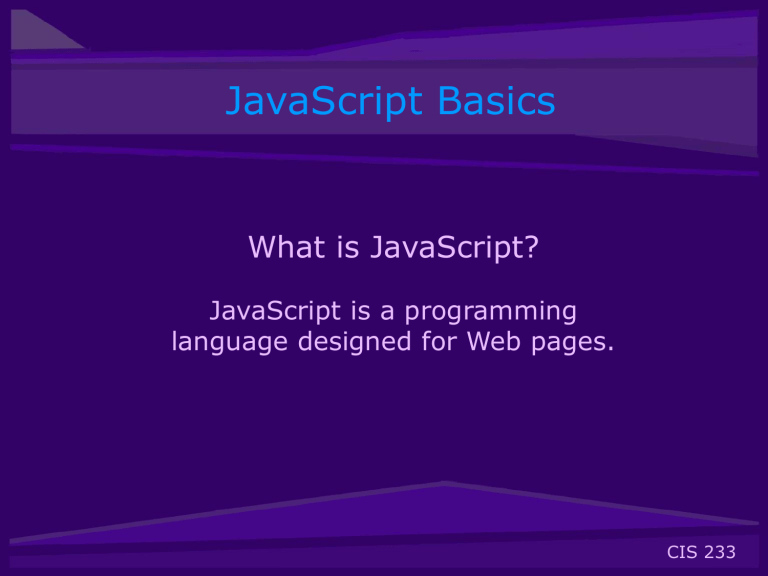JavaScript Basics PowerPoint

JavaScript Basics
What is JavaScript?
JavaScript is a programming language designed for Web pages.
CIS 233
Why Use JavaScript?
• JavaScript enhances Web pages with dynamic and interactive features.
• JavaScript runs in client software.
• JavaScript 1.3 works with version 4.0 browsers.
CIS 233
What Can JavaScript Do?
• Common JavaScript tasks can replace serverside scripting.
• JavaScript enables shopping carts, form validation, calculations, special graphic and text effects, image swapping, image mapping, clocks, and more.
CIS 233
JavaScript Syntax.
• Unlike HTML, JavaScript is case sensitive.
• Dot Syntax is used to combine terms.
• e.g., document.write("Hello World")
• Certain characters and terms are reserved.
• JavaScript is simple text (ASCII).
CIS 233
JavaScript Terminology.
• JavaScript programming uses specialized terminology.
• Understanding JavaScript terms is fundamental to understanding the script.
• Objects, Properties, Methods, Events, Functions,
Values, Variables, Expressions, Operators.
CIS 233
Objects
• Objects refers to windows, documents, images, tables, forms, buttons or links, etc.
• Objects should be named.
• Objects have properties that act as modifiers.
CIS 233
Properties
• Properties are object attributes.
• Object properties are defined by using the object's name, a period, and the property name.
• e.g., background color is expressed by: document.bgcolor
.
• document is the object.
• bgcolor is the property.
CIS 233
Methods
• Methods are actions applied to particular objects. Methods are what objects can do.
• e.g., document.write(”Hello World")
• document is the object.
• write is the method.
CIS 233
Events
• Events associate an object with an action.
• e.g., the OnMouseover event handler action can change an image.
• e.g., the onSubmit event handler sends a form.
• User actions trigger events.
CIS 233
Functions
• Functions are named statements that performs tasks.
• e.g., function doWhatever () {statement here}
• The curly braces contain the statements of the function.
• JavaScript has built-in functions, and you can write your own.
CIS 233
Values
• Values are bits of information.
• Values types and some examples include:
• Number: 1, 2, 3, etc.
• String: characters enclosed in quotes.
• Boolean: true or false.
• Object: image, form
• Function: validate, doWhatever
CIS 233
Variables
• Variables contain values and use the equal sign to specify their value.
• Variables are created by declaration using the var command with or without an initial value state.
• e.g. var month;
• e.g. var month = April;
CIS 233
Expressions
• Expressions are commands that assign values to variables.
• Expressions always use an assignment operator, such as the equals sign.
• e.g., var month = May; is an expression.
• Expressions end with a semicolon.
CIS 233
Operators
• Operators are used to handle variables.
• Types of operators with examples:
• Arithmetic operators, such as plus.
• Comparisons operators, such as equals.
• Logical operators, such as and.
• Control operators, such as if.
• Assignment and String operators.
CIS 233
Methods of Using JavaScript.
1. JavaScripts can reside in a separate page.
2. JavaScript can be embedded in HTML documents -- in the <head> , in the
<body> , or in both.
3. JavaScript object attributes can be placed in HTML element tags.
e.g., <body onLoad="alert('WELCOME')">
CIS 233
1. Using Separate JavaScript Files.
• Linking can be advantageous if many pages use the same script.
• Use the source element to link to the script file.
<script src="myjavascript.js” language="JavaScript1.2” type="text/javascript">
</script>
CIS 233
2. Embedding JavaScript in HTML.
• When specifying a script only the tags
<script> and </script> are essential, but complete specification is recommended:
<script language="javascript” type="text/javascript">
<!-- Begin hiding window.location=”index.html"
// End hiding script-->
</script>
CIS 233
Using Comment Tags
• HTML comment tags should bracket any script.
• The <!-- script here --> tags hide scripts in HTML and prevent scripts from displaying in browsers that do not interpret JavaScript.
• Double slashes // are the signal characters for a JavaScript single-line comment.
CIS 233
3. Using JavaScript in HTML Tags.
• Event handlers like onMouseover are a perfect example of an easy to add tag script.
<a href=”index.html” onMouseover="document.logo.src='js2.gif'" onMouseout="document.logo.src='js.gif'">
<img src="js.gif" name="logo">
</a>
CIS 233
Creating an Alert Message
• The following script in the <body> tag uses the onLoad event to display an Alert window
• The message is specified within parenthesis.
<body onLoad="alert('WELCOME. Enjoy your visit. Your feedback can improve cyberspace. Please let me know if you detect any problems. Thank you.')">
CIS 233
• Return to jqjacobs.net/web -JavaScript Basics
References and Recommended Readings
The Web Wizard’s Guide to JavaScript by Steven Estrella
JavaScript for the World Wide Web by Tom Negrino and Dori Smith
©2003 by James Q. Jacobs. All rights reserved.
My photography, graphics, and writings may be used and reproduced for non-commercial, educational purposes, such as classroom materials, without my permission if you cite the source in some way.
CIS 233